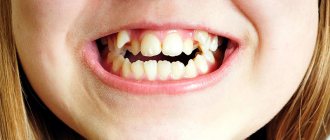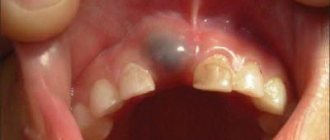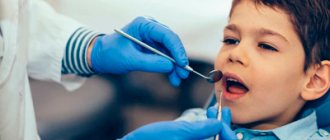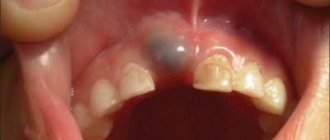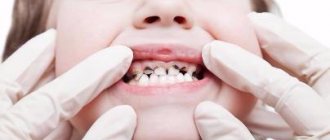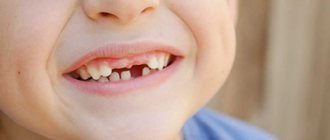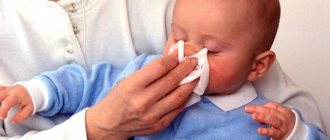What to do if your child has a pink tooth
The tooth consists of both hard and soft tissues. Inside it is soft pulp and nerves. The pulp is made up of a semi-solid material called dentin. Dentin helps form the bulk of the structure and protect the sensory nerves and blood vessels inside. Enamel is a thin coating over dentin that adds another layer of protection. Enamel helps protect dentin and pulp from bacteria. Caries that gets into the enamel and dentin and reaches the pulp can lead to its death. When decay reaches the pulp, it creates a pathway for bacteria to infect the tissue. A healthy pulp will respond to infection the same way as any other part of the body: with inflammation.
Another thing that can cause redness is injury. If you are struck in the jaw by a fall or while playing sports, it can damage blood vessels. The tooth needs blood, so when there is no more blood, it dies. This usually happens slowly over time and does not cause as much pain as when decay reaches the pulp.
During eruption, root resorption occurs. The root is absorbed and begins to dissolve. Once the root is completely resorbed, the baby tooth will fall out - so there will be no visible root. If resorption continues, a pink tint may appear. It may take about 2-3 weeks for the color to change. If the tooth turns red, this is the result of thinning or translucency of the enamel. This looks strange, but is not a cause for alarm. Parents can always consult a dentist if the child is bothered by pain or the shade becomes more intense.
The damage is usually irreversible, but sometimes it can be repaired, especially if it is caused by tooth decay. The dentist will make a diagnosis and recommend treatment.
Brown spots
Similar manifestations on tooth enamel are also caused by the development of hypoplasia. The disease is generally very common and, according to some estimates, affects up to 40% of children.
The causes of hypoplasia, in contrast to caries, which destroys still growing teeth, are complications during pregnancy or trauma during birth. It can also develop due to poor nutrition, digestive problems and damage to tooth enamel.
For prevention, it is necessary to monitor the condition of the mother’s teeth. You should stop artificial feeding and monitor the child’s nutrition subsequently, as well as regularly visit the dentist.
How to treat a pink tooth in a child
A pink tooth in a child should not cause panic. It is important to know that this is usually not a serious situation. The problem often occurs in young children and, as a rule, it is harmless - there is no harmful effect on the health of the jaw. A red tooth in a child is a sign of resorption.
If the pink discoloration is persistent, it may indicate a more serious problem and parents should consult a dentist.
The doctor can:
- put a seal;
- remove dentin;
- apply intracanal bleaching.
Treatment depends on various factors and the exact cause of the change in shade.
Disease that causes stains on teeth
A dental disease that manifests itself in the form of multi-colored spots on their surface is called hypoplasia . The disease appears during the gestation period of the future dental patient. It develops in a child if the mother, during pregnancy, had stomach problems, and also had a lack of vitamin D or was exposed to a viral disease.
In such cases, it is necessary to increase the child’s immunity and change his diet. First of all, it is necessary to exclude the possibility of excessive amounts of fluoride entering the body. To do this, you should avoid toothpaste with a high content of it. You need to give your child only purified (bottled or filtered) water, and also give him more vitamins, vegetables and fruits.
With the development of the disease, expressed in the appearance of new spots and an increase in the area of existing ones, remineralization is necessary. The procedure consists of the dentist coating the teeth with a special paste containing substances designed to strengthen the enamel. For hypoplasia detected before the age of eighteen, fluoridation or silvering is also performed.
What to do if an adult’s tooth turns red
As resorption occurs, the pink or red color becomes more noticeable and the structure changes. If you catch the early stage of dying, there is a chance to preserve the external structure. The internal, damaged pulp can be cleaned out and replaced with a hard filling material that will help protect the structural integrity. Preserving as much of the original structure as possible is important for oral health. Gaps in your smile can lead to poor jawbone health, uneven bites, bacterial growth, and cosmetic problems.
If severe damage is observed, removal will likely be the best option. It is recommended to get an implant to maintain the health of your jaw and mouth.
Treatment of stained teeth at the Family Dentist clinic
We have experienced doctors who have been treating caries and non-carious lesions for 15–20 years, and accurately identify the spotted form of hypoplasia. White spots on teeth are similar to early caries and fluorosis. We identify the disease by its shape, color intensity, localization of lesions, smoothness or roughness of the enamel layer. We dry the teeth, examine them under fluorescent lighting, and stain them with methylene solution.
Our pediatric dentists provide attention and care, treat restless and capricious little patients with patience, and make diagnosis and treatment comfortable. Children leave in a good mood and are not afraid to come again.
Dental hypoplasia is irreversible; treatment consists of strengthening the enamel layer and restoring chips, cracks, and color. We select treatment tactics depending on the severity of the disorders and take into account the condition of hard tissues.
We perform remineralizing therapy to strengthen the enamel and prevent caries at the site of the spots. We apply applications or mouth guards with preparations containing phosphorus and calcium. To increase the effectiveness of remineralization, after completing the course we fluoride the teeth to prevent calcium leaching. For hygiene, we recommend prophylactic pastes with fluorides, phosphates, hydroxyapatite crystals, and calcium. In Minsk there are good pastes: Apadent Kids, Children's Pearls, Lacalut Kids, Biorepair Kids.
We excise areas with erosion and install a filling if we are treating brown spots on children’s teeth. Our clinic uses reliable filling materials with fluoride, which are indistinguishable in shine and color from natural enamel. Filling prevents the appearance of cracks, the penetration of microbes, and gives the smile an aesthetic appearance.
We use whitening in older children with slight clouding of the enamel. Whitening methods are effective for isolated chalky stains.
If you notice white or brown spots on your child's teeth, make an appointment with our family dentistry. We will strengthen the enamel, restore damaged areas, and eliminate cosmetic defects.
Why does a filled tooth suddenly turn pink?
If dental treatment was successful, but the healed tooth hurts, this does not indicate any problems, but gives reason to consult a dentist. If the filled tooth turns pink, this may be the result of the fact that the paste contained resorcinol and formaldehyde. But most often the change signals pulpitis, periodontitis, traumatic injury or rupture of a vessel in the pulp.
If a tooth turns red, you should immediately contact your dentist to get a diagnosis. A potential infection should not be left unattended; it is important to ask what treatment options are available and make an informed decision.
Priestley's Raid
Having noticed that the child’s front tooth has darkened, parents take a closer look at other units and may find that dark plaque covers the entire dentition in the area adjacent to the gingival margin.
This is what Priestley's plaque looks like - a bacterial film formed due to dysbacteriosis in combination with lack of dental care. The film stains and becomes darker over time. It is not possible to remove thick plaque on your own, but the dentists at the Shifa clinic have all the necessary equipment to use painless techniques to rid the child’s teeth of staining.
In this case, it would not hurt to consult a gastroenterologist and endocrinologist for early detection of systemic general pathology.
Varieties
Today, there are two main classifications of tooth root inflammation - classification according to the place of origin of the inflammatory process and according to the form of the disease.
Based on the location of the inflammatory process, apical and marginal periodontitis is distinguished. Apical periodontitis forms in the area near the base of the root and the upper root part, marginal periodontitis begins in the gum area. Apical periodontitis, as a rule, occurs as a result of advanced pulpitis, while marginal periodontitis occurs as a result of trauma.
According to the form of the disease, dentistry distinguishes between acute and chronic periodontitis. The acute form of the disease is characterized by a sharp onset, intense pain (usually when pressing on a tooth and eating hot food), sometimes an increase in body temperature and swelling of the gums at the site of the pathological process and the formation of a fistula. Acute periodontitis can be serous or purulent. In the serous form, the pain is inconsistent; the purulent form is accompanied by a gradual increase in pain and the release of pus from the gums.
If you do not seek dental help at this stage, acute periodontitis can become chronic. In the chronic course of the disease, less pronounced symptoms are observed; as a rule, there is no increase in temperature (however, it can occur during an exacerbation). Mobility of the affected tooth appears, as well as a feeling of heaviness and swelling of the tooth from the inside.
Chronic inflammation of the tooth root occurs in three forms: fibrous, granulating and granulomatous.
The fibrous form of periodontitis can sometimes be detected only with the help of an x-ray or computed tomogram, since this form of chronic inflammation of the tooth root often does not manifest itself symptomatically. Elderly people often experience this form of periodontitis. With this form of the disease, the tissue around the tooth becomes pale pink, and the tooth itself may darken.
The granulating form is diagnosed more often than others. With this form, a channel forms in the gum through which pus comes out. Granulation tissue develops, which grows and can have a negative effect on the bone.
In the granulomatous form of chronic periodontitis, sacs filled with pus form on the gums. Granulomas appear at the apex of the tooth root, which separate the affected part of the tooth from the healthy part.
Ignoring chronic periodontitis can lead to a weakening of the body's immune system, resulting in a constant, low-grade inflammatory process.
Caries of primary teeth and its ENT complications
Sometimes parents unsuccessfully try to understand why their child often suffers from colds, complains of ear pain, and suffers from a chronic runny nose. And few people realize that the reason for weakened immunity lies in the baby’s untreated teeth. How can this be? It turns out that it’s all about pathogens! Caries develops under the influence of pathogenic bacteria, which can also cause diseases of the gastrointestinal tract and respiratory system of the child. Therefore, timely treatment of caries is important, including for maintaining the normal functioning of other organs of the baby.
How to identify milk caries?
It is quite simple to identify caries in young and older children. White or brown spots appear on the teeth, a painful reaction to hot and cold is observed, and the child may develop bad breath. When these first symptoms of caries appear, it is already worth sounding the alarm, since the carious process is developing very rapidly. It is characterized by almost instantaneous damage to several teeth, and if measures are not taken, the entire dentition may be affected. Of course, it is often difficult for a child to articulate that his baby tooth hurts. He may refuse to eat or chew on only one side. This should also alert parents and encourage them to take their child to pediatric dentistry.
Do baby teeth hurt due to caries?
Painful sensations when the surface of the teeth comes into contact with sweet, sour or salty food irritants is one of the first signs of incipient caries on baby teeth. Further, the discomfort in the affected teeth will only intensify, and when caries affects the pulp, the teeth begin to hurt like adults. In addition to acute pain, this stage of the disease is characterized by a high risk of premature removal of a baby tooth.
Publisher: Expert magazine about dentistry Startsmile.ru
Author of the material: Ekaterina Gasparova
My gums hurt after filling a tooth, what should I do?
If, after installing a filling, your gums are very sore and even your cheek is swollen, you cannot do without the help of a dentist. Moreover, it is necessary to contact as soon as possible so that there are no even more unpleasant consequences.
A few tips to relieve pain:
- applying an ice compress to the cheek at the sore spot for several minutes or a compress with ice cubes;
- alternate application of compresses with warm rinses from decoctions of medicinal herbs or infusions;
- painkillers;
- balms to strengthen teeth and gums.
Attention! Under no circumstances should you apply hot or warm compresses - they actively provoke inflammation and pain!
Taking antibiotics without a doctor's prescription is also extremely contraindicated, because this can lead to a decrease in immunity and complicate further treatment.
Preventive measures
After filling a tooth, during the first week, you must strictly follow the main rules so that pain does not occur, or it disappears as soon as possible:
- do not drink or eat too cold or too hot, as temperature changes provoke pain;
- every time after eating, brush your teeth and rinse your mouth with special anesthetic rinses (the ASEPTA series includes rinses with an analgesic and disinfecting effect);
- try to eat softer foods so as not to damage the periodontal tissues, and it is preferable to chew only on the healthy side;
- do not smoke, as the tooth disturbed by treatment is very sensitive in the first days.
Prevention of caries in children
Prevention of childhood caries includes several areas, which boil down to proper nutrition, as well as home and professional hygiene.
- Individual oral hygiene. Home hygiene means that as soon as the first tooth hatches, a brush for the baby should appear in a glass next to the parents’ brushes. The same applies to toothpaste. At first, the paste can be applied to gauze or a fingertip to clean your teeth so as not to injure your delicate gums. You need to clean your teeth from all surfaces vertically, then wipe them with a brush soaked in water. Thus, firstly, plaque will be removed, and, secondly, parents will teach the baby to take care of the oral cavity.
- Prevention of caries with the help of a well-chosen diet. As for nutrition, parental duty is to breastfeed the baby from the very beginning. There is no need to talk about the beneficial properties of breast milk, and the sucking process greatly affects the developing jaw system. Then the baby should be accustomed to fermented milk products. By six months, the child should be fed kefir, and later - cottage cheese and cheese. Parents should remember that the main formation and formation of permanent teeth occurs up to 3 years. This means that calcium must always be present in the daily diet.
- Professional oral hygiene. This type of prevention involves periodic visits to the dentist and hygienist. The first visit should occur on your first birthday. The specialist will not only give recommendations for care, but also create a diet regimen and examine the mouth. When the first teeth emerge, you and your child will be shown how to brush their teeth properly at an appointment with a hygienist. If there is a problem such as tartar in children, you cannot do without professional hygienic cleaning. It is important for parents to make it a rule to visit the doctor twice a year. And if there are problems with teeth, then more often - once every three months. This is largely due to the fact that various pathologies develop too quickly in childhood. Meanwhile, early diagnosis will lead to quick, painless and relatively inexpensive treatment of caries.
As you can see, in most cases, when caries can attack children's teeth, parents are able to rebuff it decisively. Of course, there is no escape from genetic predisposition. But it’s not without reason that dental experts say that sweets are the main cause of the development of the disease! So isn’t it better to eliminate the constant source of bacteria and, instead of harmful carbohydrates, offer the child fruits, which are much healthier, after the main meal? Ultimately, your child will thank you in the future for being vigilant and maintaining healthy teeth!
Complications after granuloma at the site of an extracted tooth
Lack of timely treatment and hope that the disease will go away on its own is fraught with serious consequences. Among the most common complications it is worth highlighting:
- development of periodontitis and further formation of a fistula;
- the occurrence of alveolitis is a consequence of the presence of an inflammatory process;
- formation of purulent flux;
- suppuration of the perimaxillary tissue;
- entry of pathogenic bacteria into the lymph nodes, from where they penetrate the cardiac system and internal organs (kidneys, liver and brain);
- development of facial asymmetry;
- the emergence of new foci of infection;
- infection of the body due to the penetration of pathogenic microorganisms into the blood vessels.
Timely removal of granuloma is a guarantee to avoid unpleasant health consequences.
Causes of the disease
There are a number of reasons leading to tooth root inflammation:
- Deep caries. As you know, at the initial stage, caries is a stain that, without proper treatment, quickly deepens and covers an increasingly larger area of the tooth. Thus, caries passes through layers: enamel, then dentin, and later reaches the inner layer - the pulp. After this, pathological microorganisms can go down the root canal and cause an inflammatory process there. There is also a retrograde type of spread of infection - that is, the spread of pathogens occurs from the roots of the teeth.
- Poor quality dental care. Many people know that regardless of whether you want to remove tartar, put a filling, or just undergo a preventive examination, it is important to contact experienced dentists. Sometimes it happens that poor-quality dental care leads to periodontitis, for example, if the doctor unsuccessfully placed a filling/crown or chose the wrong treatment tactics for pulpitis (inflammation of the nerve of the tooth). There is drug-induced periodontitis, which is formed when chemicals, such as filling materials, enter the periodontal tissue. In the event of an allergic reaction, allergic periodontitis may occur.
- Injuries. Periodontitis often occurs as a result of injuries to the jaw or teeth. Sometimes the development of periodontitis is provoked by an accidental, strong bite of a hard object (for example, a fork).
- Serious inflammatory processes in the body. Sometimes inflammation of the tooth root occurs due to general intoxication of the body, when the infection spreads through the blood or lymph. Often periodontitis also occurs against the background of poisoning of the body.
